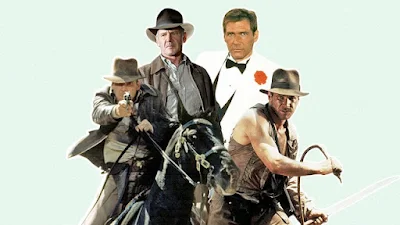Debuting the first part in 1981 with the name Indiana Jones: Raiders of the Lost Ark, Indiana Jones has become a historical milestone in adventure movies in particular and world cinema in general.
After 15 years since the last movie - Indiana Jones and the Kingdom of the Crystal Skull, the legendary Indiana Jones returned to the big screen on June 29. In this 5th film, Steven Spielberg also stepped back from the producer position to make way for the director's chair to James Mangold. The journey of the illustrious archaeologist Indy may end forever from here. But what Indiana Jones left is still worthy of a legacy, a cinema monument in the hearts of the public.
Build an Indiana Jones paper toy from Marshall Alexander with Paper Iconic and look back on Indy's journey in this article.
Indy – the greatest hero on the big screen
In 1981, producer George Lucas (father of the series Star Wars) together with the talented director Steven Spielberg gave birth to a film formed from the two people’s passion for adventure and childhood memories – Indiana Jones: Raiders of the lost ark. The character “soul” of the work is an archeology professor named Henry Walton “Indiana” Jones, people still call him by the intimate name “Indy”. Played by actor Harrison Ford, Indiana Jones is imprinted in the memory of many generations with the image of a brave, naked man with a fedora hat and a whip.
 |
| After 42 years, the film brand bearing the imprint of three outstanding talents: Steven Spielberg, George Lucas and Harrison Ford still holds a special place in the hearts of movie fans. |
During the past 42 years, and through 4 movies, Indy has been the movie hero of many audiences around the world, especially audiences of the 7X generation and millennials (only those born between 1981-1996). The American Film Academy voted Indiana Jones as the second greatest movie hero in history, behind only Atticus Finch of Kill the mocking bird. Each part of the film is a great adventure of the Dr. Jones on the way to track down the whereabouts of a certain precious artifact. With the “engine” of antiques, Indy travels through many strange lands, contacts many different civilizations and confronts evil forces.
How did ‘Indiana Jones’ affect popular culture?
Indiana Jones: Raiders of the lost ark grossed $389.9 million worldwide, making it the highest-grossing film of 1981 and still one of the highest-grossing films of all time. The film also garnered eight Academy Award nominations in 1982, kept by the National Film Archive in the Library of Congress, and is considered “culturally, historically, and aesthetically significant”. Throughout more than four decades of conquering the big screen, four episodes of Indiana Jones brought in nearly $ 2 billion in revenue worldwide, creating a strong influence on popular culture for generations.
With Indiana Jones, producers George Lucas and Steven Spielberg set new standards for American action-adventure and recreated audiences’ tastes with the mainstream. Mysterious artifacts, adventures, new lands and a hero that is not divine but “cool” enough to satisfy the “inner child” of each audience. With his clever staging talent and superior cinematography skills, Steven Spielberg has created “rustic” action sequences that don’t need guns, roaring smoke, but still strangely attractive.
Series Indiana Jones also have a significant impact on public interest and interest in archeology. Recently, when the magazine National Geographic writing an article about the “Indiana Jones effect,” reporters said most archaeologists they came in contact with referred to the film in an affectionate and amused tone.
Although the depiction of this profession in the film is much more polished than in reality, it is undeniable that it has sparked the curiosity about this profession for many people. In 2008, Harrison Ford was even honored by the American Institute of Archeology with the Bandelier Prize, praising Ford’s important role in stimulating public interest in the discovery of antiquities.
Download and build your own Indiana Jones paper toy by Marshall Alexander.




